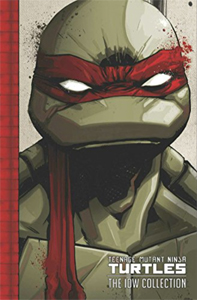When Viacom bought “TMNT” from Peter Laird, it of course set about creating product for what it saw as its biggest market: kids. Hence the 2012 cartoon, a more recent cartoon and the two Michael Bay-produced movies, which were infamous from inception to completion.
To make some cash on the side, Viacom granted the comic license to IDW, whose biggest market is adult readers. To be more specific, though, it’s adult readers who liked the cartoon and movie Turtles when they were kids.
One of the fun things about Laird’s Mirage Volume 4 in the Aughts – in addition to the stories themselves – was the letters pages. He printed nearly every letter he got, and I was amazed at how many readers requested an appearance of Ace Duck (from the Playmates toy line, and brief cameos in the cartoon and “Adventures”).

“Teenage Mutant Ninja Turtles: The IDW Collection” Volume 1 (2015)
Collects: “TMNT” No. 1-12 (2011-12), “TMNT: Micro-Series” No. 1-5 (2011-12), and “A Lot to Learn” (short comic, 2014)
Scripts: Tom Waltz (main title and “A Lot to Learn”), Brian Lynch (“Raphael,” “Michelangelo,” “Donatello,” “Leonardo”), Erik Burnham (“Splinter”)
Story: Kevin Eastman and Waltz, Bobby Curnow and Waltz (“A Lot to Learn”)
Layouts: Eastman (Issues 1-4)
Artists: Dan Duncan (main title), Franco Urro (“Raphael”), Andy Kuhn (“Michelangelo”), Valerio Schiti (“Donatello”), Sophie Campbell (“Leonardo”), Charles Paul Wilson III (“Splinter”)
Colors: Ronda Pattison (main title), Fabio Mantovani (“Raphael”), Bill Crabtree (“Michelangelo”), Scarlet Gothica and Ilaria Traversi (“Donatello”), Jay Fotos (“Leonardo,” “Splinter”)
Larid always calmly responded that his comics would not incorporate characters made for the toy line or cartoons. The worlds were separate. …
… Until the IDW comic started in 2011 as a blend of Mirage, the cartoon, the movies, the “Adventures” comic, the video games — basically every incarnation went into a blender. I was hesitant to get into a continuity with a new origin story for the Turtles. But I was intrigued by the idea of Krang, Bebop and Rocksteady – and sure, Ace Duck, if it comes to that – being given thoughtful, mature treatments.
Nostalgic yet fresh
Writer Tom Waltz – with (no small thing) Kevin Eastman providing layouts for Issues 1-4 and assisting him on the story – had a fine line to walk. He keeps his balance on “The IDW Collection” Volume 1, which collects Issues 1-12, plus the first five one-shots (primarily penned by Brian Lynch), from 2011-12. (The short comic “A Lot to Learn” from a 2014 30th anniversary special is also in the mix, as IDW aims to put these collections in precise chronological order.)
As IDW’s “Original 17” parallels Mirage’s “Original 16,” it’s nostalgic, but it’s fresh. These issues engage in an ongoing conversation with early Mirage, but different things can happen, and the cartoon serves as a toy box full of potential wild cards.

General Krang speaks in the rhythm of his counterpart from the cartoon, but his ambitions are scary rather than laughable. When he says he’s going to kill Baxter Stockman if he fails him one more time, it’s not in wishy-washy fashion like in the toon.
The most interesting character to keep an eye on is Raphael. One might wonder if we’d get Angry Raph (Mirage) or Sarcastic Raph (the cartoon). But IDW’s Raph reminds me of Rick Veitch’s controversial take on Raph from “The River.” He’s the least mature Turtle, the one who hasn’t grown into his personality.
Waltz puts Raph in this position with an opening mystery that parallels the way the other three Turtles rally around the ailing Raph – the “outsider” of the quartet — in the 1990 movie. Raph is missing — from the very point they are mutated! So when they find Raph, it marks the first time they meet him … in a way.
A multifaceted origin
Waltz and Eastman devise a clever “double” origin story. The familiar mutation of four baby turtles still applies, but a fascinating aspect of reincarnation teases out both the supernatural aspect of “TMNT” lore and the setting of feudal Japan, best known to the fandom from “TMNT III.” The Turtles are who’ve they’ve always been, but their specific emotional struggles will be new.
Waltz’s saga is slow-burn but sweeping; the nostalgia is magnetic but not creativity-crushing. There’s no Ace Duck yet, but Bebop and Rocksteady pop in, and I’m looking forward to seeing the villainous rivalry between Shredder and Krang play out in a serious way, rather than merely via insults.
Waltz’s team isn’t entirely relying on the archives: Snow fox Alopex is a great newcomer, both in her design and her Stockholm Syndrome situation wherein she works for the people who wronged her. I wonder if she could be a love interest for Raph down the road, like the fox Ninjara from “Adventures.”
The “micro-series” (a cheeky term for a one-shot) nostalgically parallels the issues from the Eighties. Raph and Casey bust heads in the “Raphael” issue, Mikey celebrates a holiday in his own adventure, and Donatello’s romp includes “Kirby dots” amid Valerio Schiti’s art (a nod to Mirage’s “Donatello,” which gave a nod to comic legend Jack Kirby).
Leo’s rain-soaked one-shot features a solo encounter with the Foot Clan, which is kept mysterious via Waltz’s decompressed world-building. Splinter gets his own issue this time, and I appreciate IDW’s effort to make him empathetic – closer to the cartoon’s intimations (if not explorations) than to Mirage’s revenge-thirsting Splinter.
Eastman gets Waltz up to speed
Eastman is rightly renowned for his layouts, and he gets IDW up and running with Issues 1-4. After that, it can’t be denied that the art (all color, and lacking the famous duo-tones) isn’t as wondrous as Eastman & Laird’s on “The Original 16.” But it’s respectable. I quickly got used to Dan Duncan’s Turtles’ bigger foreheads and shield-like plastrons, along with Splinter’s nerdy front teeth.
Waltz and Duncan play to their strengths; in the artist’s case, it’s facial expressions and overall pacing more so than fight choreography. While the Splinter-Shredder battle scene would be more epic under Eastman & Laird’s strokes, it at least has emotional depth under Waltz’s keystrokes. Privy to his thoughts, we understand how Splinter/Hamato Yoshi is weakening but he continues to fight out of respect for his sons and his murdered lover, Tang Shen.
21st century Turtles
Compared to E&L’s Turtles, the IDW Turtles are younger and more innocent (they call Splinter “father” rather than “master”), and April and Casey likewise are not set in their ways.
We may even get a love triangle – somewhat rare in April-and-Casey lore – as Casey and Purple Dragon Gang member Angel have a history. April’s and Casey’s “different sides of the track” problem is emphasized as she is a top-shelf science student (she names the Turtles, who live in the lab of Baxter, for whom she is interning) and he tries to avoid his drunken dad and find a path to a better life.
While there is an evocatively grungy feel to IDW’s NYC, we’re also reminded that this is the 21st century. For example, in the Second Time Around store, Mikey is enamored by a box of carefully bagged-and-backed vintage comics. This says 2010s more so than 1980s: Even the O’Neils’ dusty antique store knows to treat comics with care.
I suspect most fans who are even slightly open to reboots will want to cradle IDW’s take on the Turtles as well by the end of “The IDW Collection” Volume 1.

